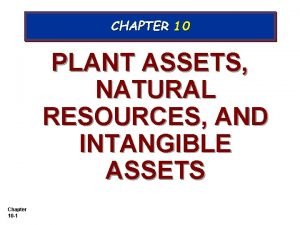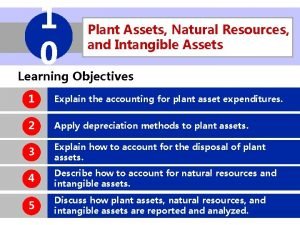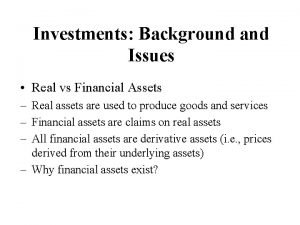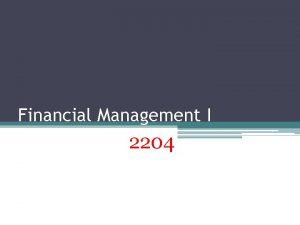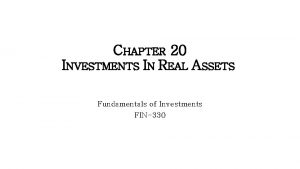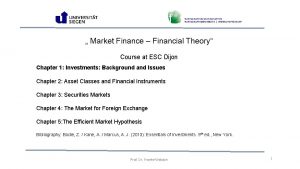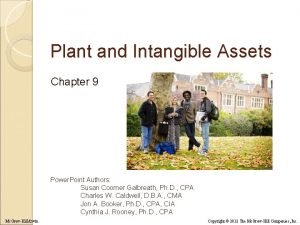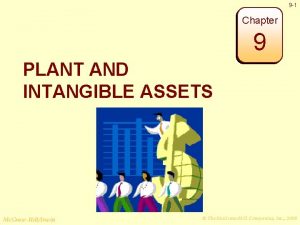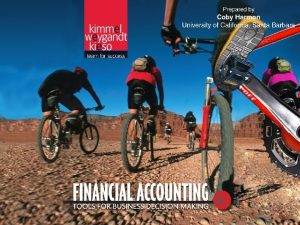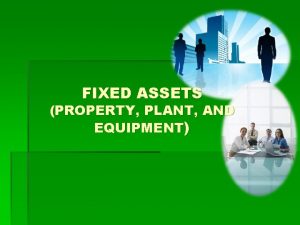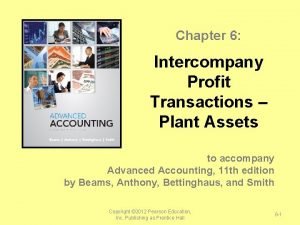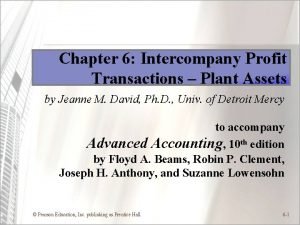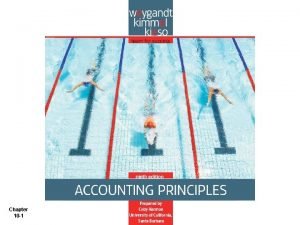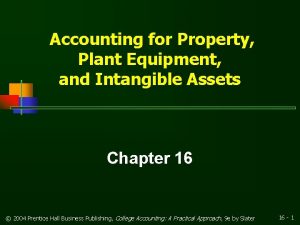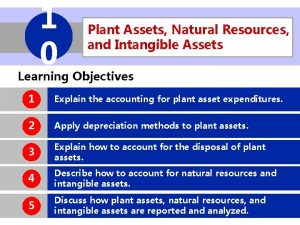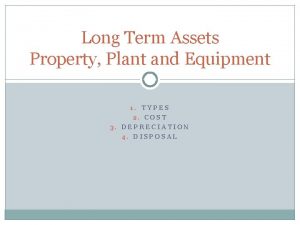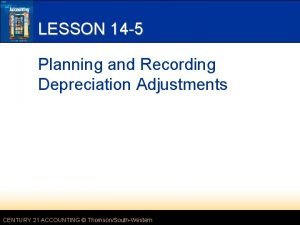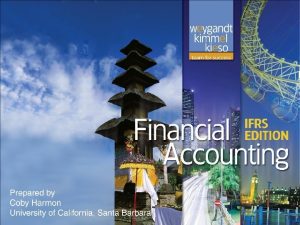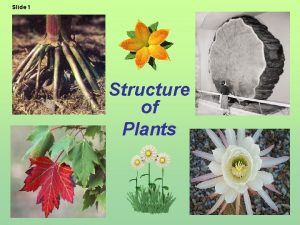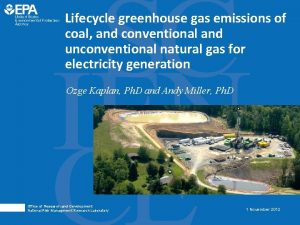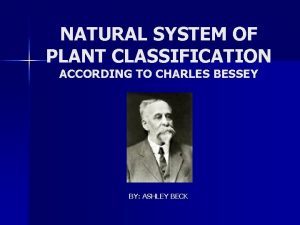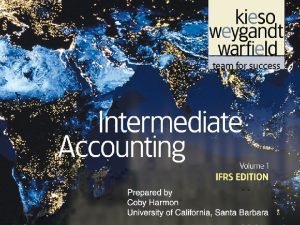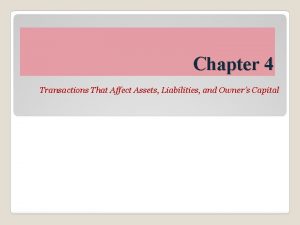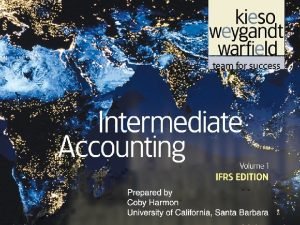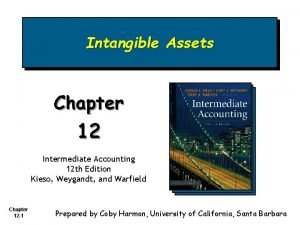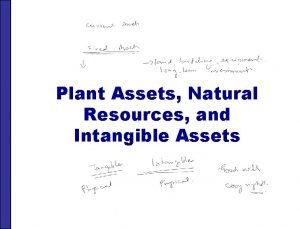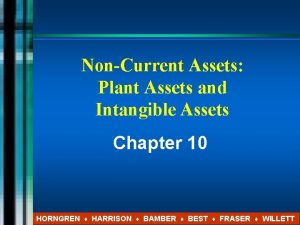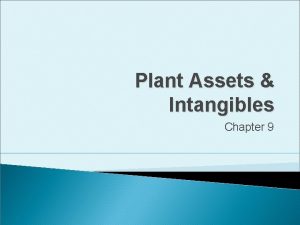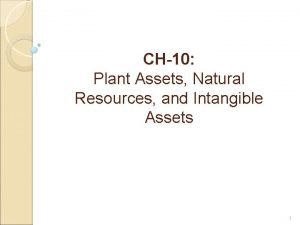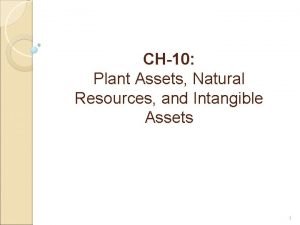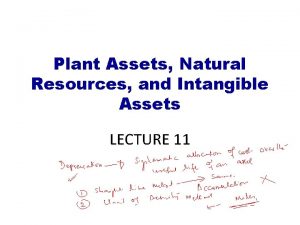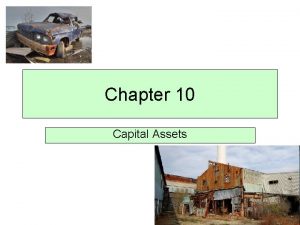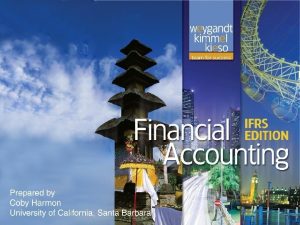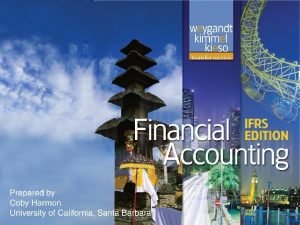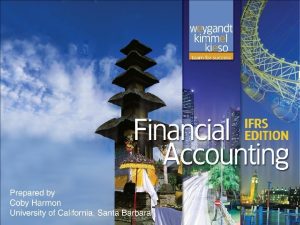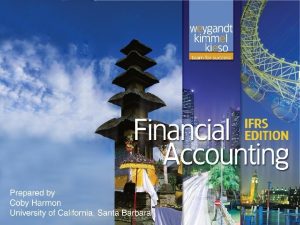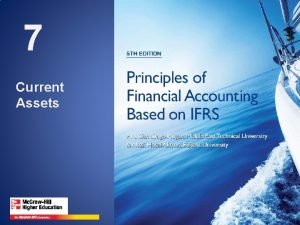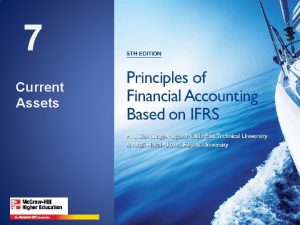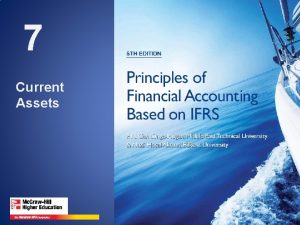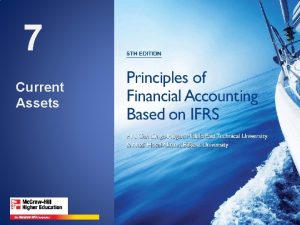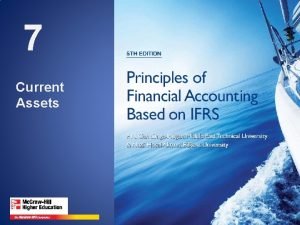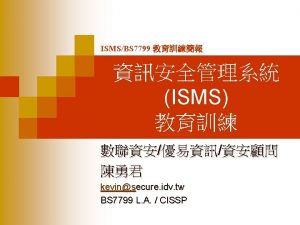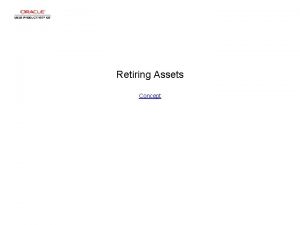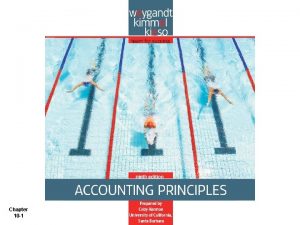Slide 9 1 Chapter 9 Plant Assets Natural

































- Slides: 33

Slide 9 -1

Chapter 9 Plant Assets, Natural Resources, and Intangible Assets Financial Accounting, IFRS Edition Weygandt Kimmel Kieso Slide 9 -2

Study Objectives Slide 9 -3 1. Describe how the cost principle applies to plant assets. 2. Explain the concept of depreciation. 3. Compute periodic depreciation using different methods. 4. Describe the procedure for revising periodic depreciation. 5. Distinguish between revenue and capital expenditures, and explain the entries for each. 6. Explain how to account for the disposal of a plant asset. 7. Compute periodic depletion of extractable natural resources. 8. Explain the basic issues related to accounting for intangible assets. 9. Indicate how plant assets, natural resources, and intangible assets are reported.

Plant Assets, Natural Resources, and Intangible Assets Plant Assets Determining the cost of plant assets Depreciation Revaluation of plant assets Expenditures during useful life Plant asset disposals Slide 9 -4 Natural Resources Accounting for extractable natural resources Financial statement presentation Intangible Assets Accounting for intangibles Types of intangibles Research and development costs Statement Presentation and Analysis Presentation Analysis

Section 1 – Plant Assets Plant assets include land, land improvements, buildings, and equipment (machinery, furniture, tools). Major characteristics include: “Used in operations” and not for resale. Long-term in nature and usually depreciated. Possess physical substance. Referred to as property, plant, and equipment; plant and equipment; and fixed assets. Slide 9 -5

Section 1 – Plant Assets Illustration 9 -1 Percentages of plant assets in relation to total assets Slide 9 -6

Determining the Cost of Plant Assets Land Includes all costs to acquire land ready it for use. Costs typically include: (1) purchase price; (2) closing costs, such as title and attorney’s fees; (3) real estate brokers’ commissions; (4) costs of grading, filling, draining, and clearing; (5) assumption of any liens, mortgages, or encumbrances on the property. Slide 9 -7 SO 1 Describe how the cost principle applies to plant assets.

Determining the Cost of Plant Assets Illustration: Assume that Hayes Manufacturing Company acquires real estate at a cash cost of $100, 000. The property contains an old warehouse that is razed at a net cost of $6, 000 ($7, 500 in costs less $1, 500 proceeds from salvaged materials). Additional expenditures are the attorney’s fee, $1, 000, and the real estate broker’s commission, $8, 000. The cost of the land is $115, 000, computed as follows. Required: Determine amount to be reported as the cost of the land. Slide 9 -8 SO 1 Describe how the cost principle applies to plant assets.

Determining the Cost of Plant Assets Required: Determine amount to be reported as the cost of the land. Land Cash price of property of $100, 000 Net removal cost of warehouse of $6, 000 Attorney's fees of $1, 000 Real estate broker’s commission of $8, 000 Cost of Land $115, 000 Journal Entry Land Cash Slide 9 -9 115, 000 SO 1 Describe how the cost principle applies to plant assets.

Determining the Cost of Plant Assets Land Improvements All expenditures necessary to make the improvements ready for their intended use. Driveways, parking lots, fences, landscaping, and underground sprinklers. Limited useful lives. Expense (depreciate) the cost of land improvements over their useful lives. Slide 9 -10 SO 1 Describe how the cost principle applies to plant assets.

Determining the Cost of Plant Assets Buildings All costs related directly to purchase or construction. Purchase costs: Purchase price, closing costs and real estate broker’s commission. Remodeling and replacing or repairing the roof, floors, electrical wiring, and plumbing. Construction costs: Contract price plus payments for architects’ fees, building permits, and excavation costs. Slide 9 -11 SO 1 Describe how the cost principle applies to plant assets.

Determining the Cost of Plant Assets Equipment All costs incurred in acquiring the equipment and preparing it for use. Costs typically include: purchase price, sales taxes, freight and handling charges, insurance on the equipment while in transit, assembling and installation costs, and costs of conducting trial runs. Slide 9 -12 SO 1 Describe how the cost principle applies to plant assets.

Determining the Cost of Plant Assets Illustration: Assume Merten Company purchases factory machinery at a cash price of $50, 000. Related expenditures are for sales taxes $3, 000, insurance during shipping $500, and installation and testing $1, 000. Determine amount to be reported as the cost of the machinery. Machinery $50, 000 Cash price 3, 000 Sales taxes Insurance during shipping Installation and testing Cost of Machinery Slide 9 -13 500 1, 000 $54, 500 SO 1 Describe how the cost principle applies to plant assets.

Slide 9 -14 Answer on notes page

Depreciation is the process of allocating the cost of tangible assets to expense in a systematic and rational manner to those periods expected to benefit from the use of the asset. Process of cost allocation, not asset valuation. Applies to land improvements, buildings, and equipment, not land. Depreciable, because the revenue-producing ability of asset will decline over the asset’s useful life. Slide 9 -15 SO 2 Explain the concept of depreciation.

Depreciation Factors in Computing Depreciation Illustration 9 -6 Cost Slide 9 -16 Useful Life Residual Value SO 2 Explain the concept of depreciation.

Depreciation Methods Objective is to select the method that best measures an asset’s contribution to revenue over its useful life. Examples include: (1) Straight-line method. (2) Units-of-Activity method. (3) Declining-balance method. Slide 9 -17 SO 3 Compute periodic depreciation using different methods.

Depreciation Straight-Line Expense is same amount for each year. Depreciable cost - cost of the asset less its residual value. Illustration 9 -8 Slide 9 -18 SO 3 Compute periodic depreciation using different methods.

Depreciation Units-of-Activity Companies estimate total units of activity to calculate depreciation cost per unit. Expense varies based on units of activity. Depreciable cost is cost less residual Slide 9 -19 Illustration 9 -10 value. SO 3 Compute periodic depreciation using different methods.

Depreciation Declining-Balance Decreasing annual depreciation expense over the asset’s useful life. Declining-balance rate is double the straight-line rate. Rate applied to book value. Illustration 9 -12 Slide 9 -20 SO 3 Compute periodic depreciation using different methods.

Depreciation Comparison of Methods Illustration 9 -14 Illustration 9 -15 Slide 9 -21 SO 3 Compute periodic depreciation using different methods.

Depreciation Review Question Depreciation is a process of: a. valuation. b. cost allocation. c. cash accumulation. d. appraisal. Slide 9 -22 SO 3 Compute periodic depreciation using different methods.

Depreciation for Partial Year The following four slides are included to illustrate the calculation of partial-year depreciation expense. The amounts are consistent with the previous slides illustrating the calculation of depreciation expense. Slide 9 -23 SO 3 Compute periodic depreciation using different methods.

Depreciation for Partial Year Illustration: Barb’s Florists purchased a small delivery truck on October 1, 2011. Illustration 9 -7 Required: Compute depreciation using the following. (a) Straight-Line Slide 9 -24 (b) Units-of-Activity (c) Declining Balance. SO 3 Compute periodic depreciation using different methods.

Depreciation and Income Taxes Tax laws often do not require the taxpayer to use the same depreciation method on the tax return that is used in preparing financial statements. Many corporations use straight-line in their financial statements to maximize net income. At the same time, they use an accelerated-depreciation method on their tax returns to minimize their income taxes. Slide 9 -25 SO 3 Compute periodic depreciation using different methods.

Depreciation Revising Periodic Depreciation Accounted for in the period of change and future periods (Change in Estimate). Not handled retrospectively. Not considered error. Slide 9 -26 SO 4 Describe the procedure for revising periodic depreciation.

Depreciation Review Question When there is a change in estimated depreciation: a. previous depreciation should be corrected. b. current and future years’ depreciation should be revised. c. only future years’ depreciation should be revised. d. None of the above. Slide 9 -27 SO 4 Describe the procedure for revising periodic depreciation.

Revaluation of Plant Assets IFRS allows revaluation of plant assets to fair value If revaluation is used, it must be applied to all assets in a class of assets. Assets that are experiencing rapid price changes must be revalued on an annual basis, otherwise less frequent revaluation is acceptable. Slide 9 -28 SO 4 Describe the procedure for revising periodic depreciation.

Revaluation of Plant Assets Pernice now reports the following information in its statement of financial position at the end of year 1. Illustration 9 -18 $850, 000 is the new basis of the asset. Pernice reports depreciation expense of $200, 000 in the income statement and $50, 000 in other comprehensive income. Depreciation in year 2 will be $212, 500 ($850, 000 / 4). Slide 9 -29 SO 4 Describe the procedure for revising periodic depreciation.

Expenditures During Useful Life Ordinary Repairs - expenditures to maintain the operating efficiency and productive life of the unit. Debit - Repair (or Maintenance) Expense. Referred to as revenue expenditures. Additions and Improvements - costs incurred to increase the operating efficiency, productive capacity, or useful life of a plant asset. Debit - the plant asset affected. Referred to as capital expenditures. Slide 9 -30 SO 5 Distinguish between revenue and capital expenditures, and explain the entries for each.

Plant Asset Disposals Companies dispose of plant assets in three ways — Retirement, Sale, or Exchange (appendix). Illustration 9 -19 Record depreciation up to the date of disposal. Eliminate asset by (1) debiting Accumulated Depreciation, and (2) crediting the asset account. Slide 9 -31 SO 6 Explain how to account for the disposal of a plant asset.

Plant Asset Disposals Sale of Plant Assets Compare the book value of the asset with the proceeds received from the sale. If proceeds exceed the book value, a gain on disposal occurs. If proceeds are less than the book value, a loss on disposal occurs. Slide 9 -32 SO 6 Explain how to account for the disposal of a plant asset.

Plant Asset Disposals - Sale Illustration 9 -20 Computation of gain on disposal Illustration: Wright records the sale as follows. July 1 Slide 9 -33 Cash 16, 000 Accumulated depreciation 49, 000 Office equipment 60, 000 Gain on disposal 5, 000 SO 6 Explain how to account for the disposal of a plant asset.
 Truck and plant assets
Truck and plant assets Accumulated depreciation straight line method
Accumulated depreciation straight line method Plant assets, natural resources, and intangible assets
Plant assets, natural resources, and intangible assets Heel and toe polka dance steps
Heel and toe polka dance steps Financial assets and real assets
Financial assets and real assets Real assets vs financial assets
Real assets vs financial assets Real assets and financial assets ppt
Real assets and financial assets ppt Lanni products is a start up computer
Lanni products is a start up computer Chapter 9 plant and intangible assets
Chapter 9 plant and intangible assets Plant and intangible assets chapter 9
Plant and intangible assets chapter 9 Common stock cash flow
Common stock cash flow Fixed assets property plant equipment
Fixed assets property plant equipment Intercompany profit transactions plant assets
Intercompany profit transactions plant assets Intercompany profit transactions plant assets
Intercompany profit transactions plant assets Ordinary repairs
Ordinary repairs Property, plant, and equipment and intangible assets are
Property, plant, and equipment and intangible assets are Units of activity method
Units of activity method Plant assets are used in operations
Plant assets are used in operations Recorded depreciation expense on the plant assets
Recorded depreciation expense on the plant assets Ordinary repairs
Ordinary repairs Factor
Factor Guard cell function in leaf
Guard cell function in leaf Objective of plant breeding
Objective of plant breeding Plant breeding for disease resistance
Plant breeding for disease resistance Plant introduction in plant breeding
Plant introduction in plant breeding Tronsmo plant pathology and plant diseases download
Tronsmo plant pathology and plant diseases download Tronsmo plant pathology and plant diseases download
Tronsmo plant pathology and plant diseases download Tronsmo plant pathology and plant diseases download
Tronsmo plant pathology and plant diseases download Natural gas power plant efficiency
Natural gas power plant efficiency Natural system of plant classification
Natural system of plant classification Intangible assets accounting example
Intangible assets accounting example Chapter 4 review transactions that affect assets
Chapter 4 review transactions that affect assets Chapter 12 intangible assets
Chapter 12 intangible assets Classification of intangible assets
Classification of intangible assets

